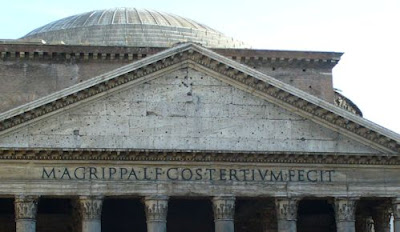The Alphabet and Latin
Rome has a rich and long history that goes back 2800 years to the Etruscans and the Greeks and it has been the center of Christianity for the last 2000 years. It was the first city to reach a population of about a million people at the apex of the territorial expansion in the third century AD. Imagine a single political entity covering Europe, the British Isles, North Africa and the Middle East with long periods of peace, one language and one currency. Rome is called the eternal city as one of the great cities in history and for its vast contribution to western civilization. The Roman alphabet and Latin are among the most important.
The alphabet used in the ancient Roman language is known as the Roman alphabet. It was influenced by the earlier Greek alphabet and the Etruscan alphabet but the Romans developed it further. With the passage of time, a script with upper and lower case letters was developed. Although over the centuries different letter-forms appeared, especially in the medieval period, the ancient forms the Romans carved into stone inscriptions are still used today. After all, the ubiquitous font Times New Roman is clearly a reflection of that early writing.
Latin was originally spoken in the area around Rome, known as Latium. Through the power of the Roman Republic, it subsequently would quickly spread over a larger part of Italy, in direct correlation to Roman conquests. Latin became the language of conquered areas because local people started speaking it, and not because the population was displaced by Latin-speakers. Latin was not imposed officially on peoples brought under Roman rule. Latin was the official language and was necessary for anyone seeking to play an important role in administration, politics, and military.
With the foundation of the Roman Empire, a large portion of the western world would come to speak various forms of Latin or have it intermingled with their own tongues. The Roman Legions carried a spoken form of Latin throughout the Roman provinces. Especially in the rest of Italy, Gaul (France) and Spain, this would become mixed with the local languages, and lead to the new languages known as the Romance languages. Without Latin, very few of the tongues we speak today would be possible or recognizable in their current forms.Latin survived the fall of the Roman Empire. As the centuries passed, it continued to be an international language of the educated and social elite, accompanying the modified tongues of the common people. The language of the Catholic Church was Latin, and all scholarly, historical, or scientific work was written in it. After the medieval period, with the Renaissance, interest in classical Latin as a means of artistic and literary expression grew. Many ancient manuscripts were re-discovered and appreciated during this time.
Latin continues to be important in scientific, medical and legal terms, which allow easy comprehension in the various western languages. For example, Latin is frequently used in medical terminology, such as “bacterium”, “umbilicus”, “cerebellum”, etc. Latin was used in creating the scientific names for flora and fauna. After the Dark Ages, from the twelfth century on, the economic and social development in Europe led to the rediscovery of Roman law, which was then assimilated by many European countries. Still today, we use terms like “modus operandi”, “habeas corpus”, “veto”, “quid pro quo”, “ad hoc” and “ipso facto.”
The Latin language is the bedrock of the language of Western Civilization. Modern students find that having a basis in Latin is useful for learning Romance languages, and even to improve their vocabulary in English.
 |
| Inscription from the time of emperor Claudius |
The museum includes an epigraphy section dedicated to Latin inscriptions, including vases, sarcophagi, tombstones and objects worked in metal. The ground floor includes the most ancient writings in Latin and in Greek in Italy. Among the most important are ceramic fragments with the writing REX (Latin for “king”), found near the Regia in the Roman Forum, and the dedications to Castor and Pollux found near Lavinio, a town near Rome. Also on the ground floor are inscriptions which describe the popular associations in “colleges of occupations” which, according the historian Plutarch, go way back to the king Numa, that is to the sixth century BC. There are traces of writing of merchants and artisans, freemen and slaves, butchers and sellers of flowers, flutists, and associations for actors and singers.



I adore your book! I bought it last summer and carried it all around Rome, reading and doing the walks cover-to-cover over the course of five weeks. I learned so much - and also realised how very much more I have to learn. I'm heading off to Rome for another five weeks this summer; Walk Rome will be by my side. Thank you for creating such a wonderful, intelligent guidebook (so much more than a 'guidebook' really). I wish you every success!!
ReplyDelete